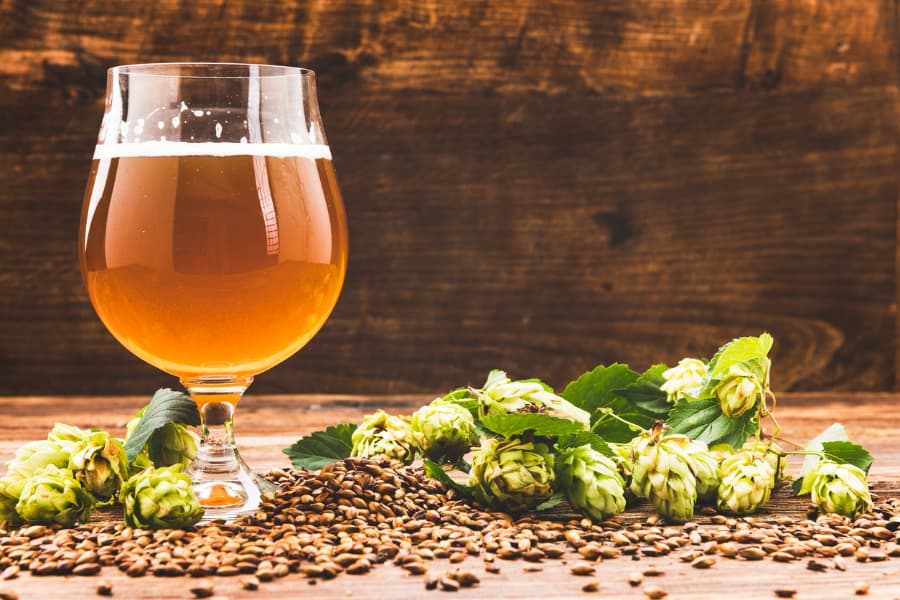
There’s nothing quite like a cold, refreshing pint from your favorite brand. But what gives it that flavor you love? The secret lies in the ingredients – namely the hops. There is a huge variety of beers on the market today that differ in flavor profile and aroma, and hops do more than contribute to the bitterness of the brew. Here, Columbia Distributing discusses the role hops play in the ingredient list and how they affect the taste of your beer.
What Are Beer Hops?
The main ingredients in most types of beer include water, malt, yeast, and hops. Hops are cone-shaped flowers that come from the humulus lupulus plant, a climbing perennial that flourishes in moderate climates across the globe. Hops contribute to a lush, foamy head and help the beer stay fresh for longer periods. However, each green cone contains small, yellow pods called lupulin. And although many craft brewers use other ingredients to create specific flavor profiles, lupulin is where your preferred beer likely gets its delightfully bitter taste.
Hops fall into two general categories: bittering and aroma. Bittering hops are higher in alpha acids, making it easier for brewers to achieve a sufficiently pungent flavor. Rich in essential oils, aroma hops make the beer smell “hoppier.”
How Hops Are Incorporated
Brewing the perfect batch of beer requires more forethought than the average consumer may realize. When it comes to hops, the key considerations are amount, type, and timing. Adding hops late in the brewing process contributes more to the beer’s aroma, while adding them sooner contributes to the bitterness. Brewers may use the following methods:
- Dry hopping: This term lets you know that the hops were added later in the brewing process, during conditioning or fermentation. It adds more aroma and flavor. Some brewers boast double or triple dry-hopped beers to indicate the amount added.
- Wet hopping: This method requires adding freshly picked hops to the brew, which can be done at any point in the brewing process. Brewers can use the hops to be a subtle addition to blend with other flavors, or they can be used to make bolder flavors.
While some brewers have access to fresh hops from local growers, many companies use pellets. Growers take their fresh hops and turn them into pellets to sell in easily transportable packaging. Dry hops boast a longer shelf life and promote consistency across brewing systems, which makes them desirable to many breweries.
Types of Hops
Just like wine can be made using different kinds of grapes, beer can be made using different kinds of hops. And many types are heavily influenced by the region they’re grown in. Some well-known varieties include the following:
- Amarillo hops: A dual-propose ingredient, Amarillo hops contribute to the bitterness and aroma of the brew to create a rich, well-rounded profile.
- Citra hops: Widely used in home, commercial, and craft brewing, Citra hops have a strong, pungent flavor ideal for bittering and aromatic purposes. This variety is used in many popular IPAs and pale ales, such as in brands like Sierra Nevada Brewing Co.
- Cascade hops: This type was first developed in Oregon. With a citrus aroma and spicy notes, Cascade is commonly used in home and commercial craft brews, such as IPAs, APAs, and many other American ales.
- Centennial hops: Striking a balance between aromatic and bittering, Centennial hops are used in many pale ales, IPAs, and bitters. This type is used by brands like Green Flash Brewing Co.
- Saaz hops: With its soft bittering qualities, this is one of the most popular varietals in the market. It’s widely used in Belgian ales, light lagers, and pilsners, such as in brands like Lost Coast Brewery.
- Mosaic hops: This varietal is a product of Nugget and Simcoe hops. It’s also one that’s sought after for its aromatic properties, adding earthy, pine, and fruity aromas to pale ales, IPAs, and stouts.
While these and numerous other varieties can be used to create distinct flavor profiles that consumers have come to know and love, other ingredients contribute as well. Hops can certainly enhance the bitterness, but so can orange zest, juniper, and more.
Find Beer for Your Store, Restaurant, or Bar
Now that you know more about beer hops, you can educate your clientele. Columbia Distributing is one of the largest beverage distributors in the United States. We offer a wide selection of beer and other alcoholic beverages from several brands and deliver them to restaurants, bars, and event centers across our broad service area in the Pacific Northwest. To learn more about our selection, contact us today.